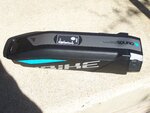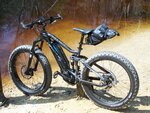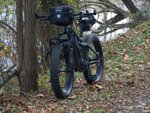D
Deleted member 4210
Guest
The attached link is not a 'technical video', but does a fairly decent job of delineating the difference between Yamaha's new ebikes, and the rest of the e-assist configurations on the market.
I've ridden about 80 different models, from more than 50 brands over the past 3 years, and when it comes down to it, after you get over the 'excitement' of having assist, then you really need to decide how you want to use assist. In otherwords, do you want to still get exercise like on a regular bike, with assist helping you along like a 'tailwind' to achieve a higher pace (speed) consistently, OR do you want the ebike motor to do more of the work, and you don't mind the inconsistency of the assist, where as long as you are peddling, the motor works, with most of the time delivering a LOT more of the assist (greater portion of the work than you are doing), or sometimes not so much but you can't really control it well, beyond the rotation speed.
Some torque sensing methods out there do accomplish a more natural feel, but from the many brands I have tried its just too inconsistent, and doesn't take into account speed. Sometimes it can be really hard or a lot of effort, with no corresponding level of assist from the motor (again its supposed to be sensing how hard you pedal), and sometimes you barely press, and the ebike just shoots off like a bat out of h*ll. Worse, quite often the torque sensing does not stay in 'tune' very well over time, so it doesn't feel the same say 6 months to a year after you ride the ebike versus the first time. Cadence sensing is of course, based on pedal rotation. The worst case scenario is that you are merely 'ghost pedaling' and the motor is doing almost nearly all of the work, and your legs are sort of 'faking' that you are riding.
The approach to how you want to use assist, also greatly affects battery capacity, so people who want the ebike to simply do most of the work, and to go 'fast', will find they likely need or want a battery that is 17 AH and up, just to go 40 or 50 miles.
If however you choose to have your ebike as much like a regular bike as possible, and just giving you a more modest level of assist like a tailwind at all times, then you really might want to check out the Yamaha brand of ebikes, where they have 3 different sensing systems, that allow you to get the most natural ride possible, and concurrently it is one of the lightest ebikes on the market with such a long range, and comfortable position. (modest lean forward which is the best for your back and spine).
Anyway, the attached video is nothing like Court's that he does here, but it is a nice little introduction to a rather subtle, but very real, difference in how mid drives can operate, and Yamaha's ebike is certainly a lot more refined than any hub drive I have ridden. Best of all, it feels and is of a quality level more like some of the $4000 to $5000 price range ebikes I have ridden, or high end regular bikes, but is priced much more reasonably in the $2400 to $3200 price range with 3 of their 4 models urban road style models. a 4th model is MTB, and that still is only ~ $3400.
https://www.adventuresportsnetwork.com/gear/know-your-gear-we-review-the-yamaha-urban-rush/
I've ridden about 80 different models, from more than 50 brands over the past 3 years, and when it comes down to it, after you get over the 'excitement' of having assist, then you really need to decide how you want to use assist. In otherwords, do you want to still get exercise like on a regular bike, with assist helping you along like a 'tailwind' to achieve a higher pace (speed) consistently, OR do you want the ebike motor to do more of the work, and you don't mind the inconsistency of the assist, where as long as you are peddling, the motor works, with most of the time delivering a LOT more of the assist (greater portion of the work than you are doing), or sometimes not so much but you can't really control it well, beyond the rotation speed.
Some torque sensing methods out there do accomplish a more natural feel, but from the many brands I have tried its just too inconsistent, and doesn't take into account speed. Sometimes it can be really hard or a lot of effort, with no corresponding level of assist from the motor (again its supposed to be sensing how hard you pedal), and sometimes you barely press, and the ebike just shoots off like a bat out of h*ll. Worse, quite often the torque sensing does not stay in 'tune' very well over time, so it doesn't feel the same say 6 months to a year after you ride the ebike versus the first time. Cadence sensing is of course, based on pedal rotation. The worst case scenario is that you are merely 'ghost pedaling' and the motor is doing almost nearly all of the work, and your legs are sort of 'faking' that you are riding.
The approach to how you want to use assist, also greatly affects battery capacity, so people who want the ebike to simply do most of the work, and to go 'fast', will find they likely need or want a battery that is 17 AH and up, just to go 40 or 50 miles.
If however you choose to have your ebike as much like a regular bike as possible, and just giving you a more modest level of assist like a tailwind at all times, then you really might want to check out the Yamaha brand of ebikes, where they have 3 different sensing systems, that allow you to get the most natural ride possible, and concurrently it is one of the lightest ebikes on the market with such a long range, and comfortable position. (modest lean forward which is the best for your back and spine).
Anyway, the attached video is nothing like Court's that he does here, but it is a nice little introduction to a rather subtle, but very real, difference in how mid drives can operate, and Yamaha's ebike is certainly a lot more refined than any hub drive I have ridden. Best of all, it feels and is of a quality level more like some of the $4000 to $5000 price range ebikes I have ridden, or high end regular bikes, but is priced much more reasonably in the $2400 to $3200 price range with 3 of their 4 models urban road style models. a 4th model is MTB, and that still is only ~ $3400.
https://www.adventuresportsnetwork.com/gear/know-your-gear-we-review-the-yamaha-urban-rush/






